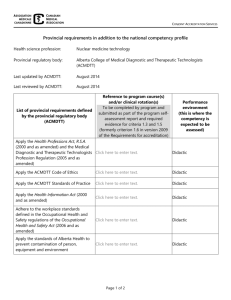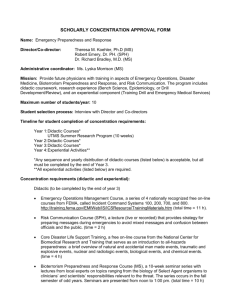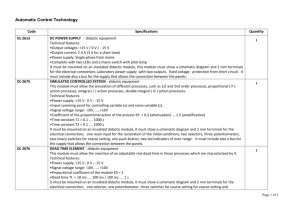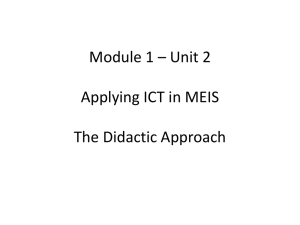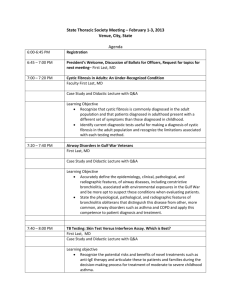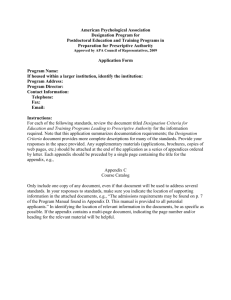Didactic Unit 0: (0.5h, session 1) Systems science and feedback
advertisement
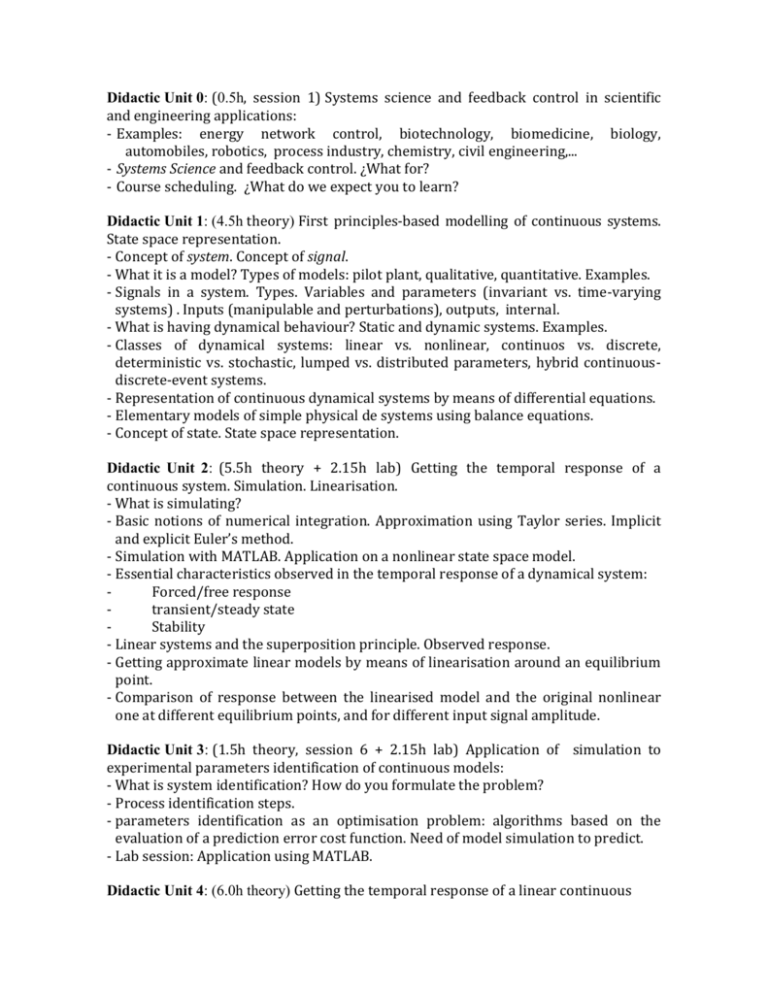
Didactic Unit 0: (0.5h, session 1) Systems science and feedback control in scientific and engineering applications: - Examples: energy network control, biotechnology, biomedicine, biology, automobiles, robotics, process industry, chemistry, civil engineering,... - Systems Science and feedback control. ¿What for? - Course scheduling. ¿What do we expect you to learn? Didactic Unit 1: (4.5h theory) First principles-based modelling of continuous systems. State space representation. - Concept of system. Concept of signal. - What it is a model? Types of models: pilot plant, qualitative, quantitative. Examples. - Signals in a system. Types. Variables and parameters (invariant vs. time-varying systems) . Inputs (manipulable and perturbations), outputs, internal. - What is having dynamical behaviour? Static and dynamic systems. Examples. - Classes of dynamical systems: linear vs. nonlinear, continuos vs. discrete, deterministic vs. stochastic, lumped vs. distributed parameters, hybrid continuousdiscrete-event systems. - Representation of continuous dynamical systems by means of differential equations. - Elementary models of simple physical de systems using balance equations. - Concept of state. State space representation. Didactic Unit 2: (5.5h theory + 2.15h lab) Getting the temporal response of a continuous system. Simulation. Linearisation. - What is simulating? - Basic notions of numerical integration. Approximation using Taylor series. Implicit and explicit Euler’s method. - Simulation with MATLAB. Application on a nonlinear state space model. - Essential characteristics observed in the temporal response of a dynamical system: Forced/free response transient/steady state Stability - Linear systems and the superposition principle. Observed response. - Getting approximate linear models by means of linearisation around an equilibrium point. - Comparison of response between the linearised model and the original nonlinear one at different equilibrium points, and for different input signal amplitude. Didactic Unit 3: (1.5h theory, session 6 + 2.15h lab) Application of simulation to experimental parameters identification of continuous models: - What is system identification? How do you formulate the problem? - Process identification steps. - parameters identification as an optimisation problem: algorithms based on the evaluation of a prediction error cost function. Need of model simulation to predict. - Lab session: Application using MATLAB. Didactic Unit 4: (6.0h theory) Getting the temporal response of a linear continuous system. I/O representation. Laplace transform. - Solution of differential equations by means of Laplace transform. first and second order basic cases. Basic properties of Laplace transform. - Input/Output representation. Transfer functions. Firs and second order cases. - Higher order cases: Going from state space to I/O representation. Block diagrams and simplification. Basic cases: series, parallel, feedback loops. - Getting the temporal response using MATLAB. Didactic Unit 5: (9.0h theory + 2.15h lab) Analysis of dynamical systems. - Poles and zeroes. - Poles and stability of continuous systems. - Characterisation of the time response and its relationship with the system poles and zeroes. First and second order systems. - Effect of zeroes. - Higher order systems - Reduced models for higher order systems. Dominant poles. - Experimental identification by means of the temporal response. - Lab session: Identification of a d.c. motor. Didactic Unit 6: (9.0h theory + 2.15h lab) Feedback and feedback control. - Feedback loops. Positive and negative feedback. Effects on the dynamic behaviour. - Basic scheme of a feedback control loop. Components. Essential transfer functions: setpoint, control input, and perturbations to output. - Effects of feedback control. Analysis using transfer functions: modification of temporal response robustness to external perturbations robustness to variations in loop components - Control specifications and their mathematical representation. - Basic control strategies - On/off control. Example: temperature control using a thermostat. - Basic control actions. proportional, derivative, integral. - Experimental tuning of PID controllers. - Model based tuning of PID controllers for low order processes. - Lab session: velocity and position control of a d.c.


